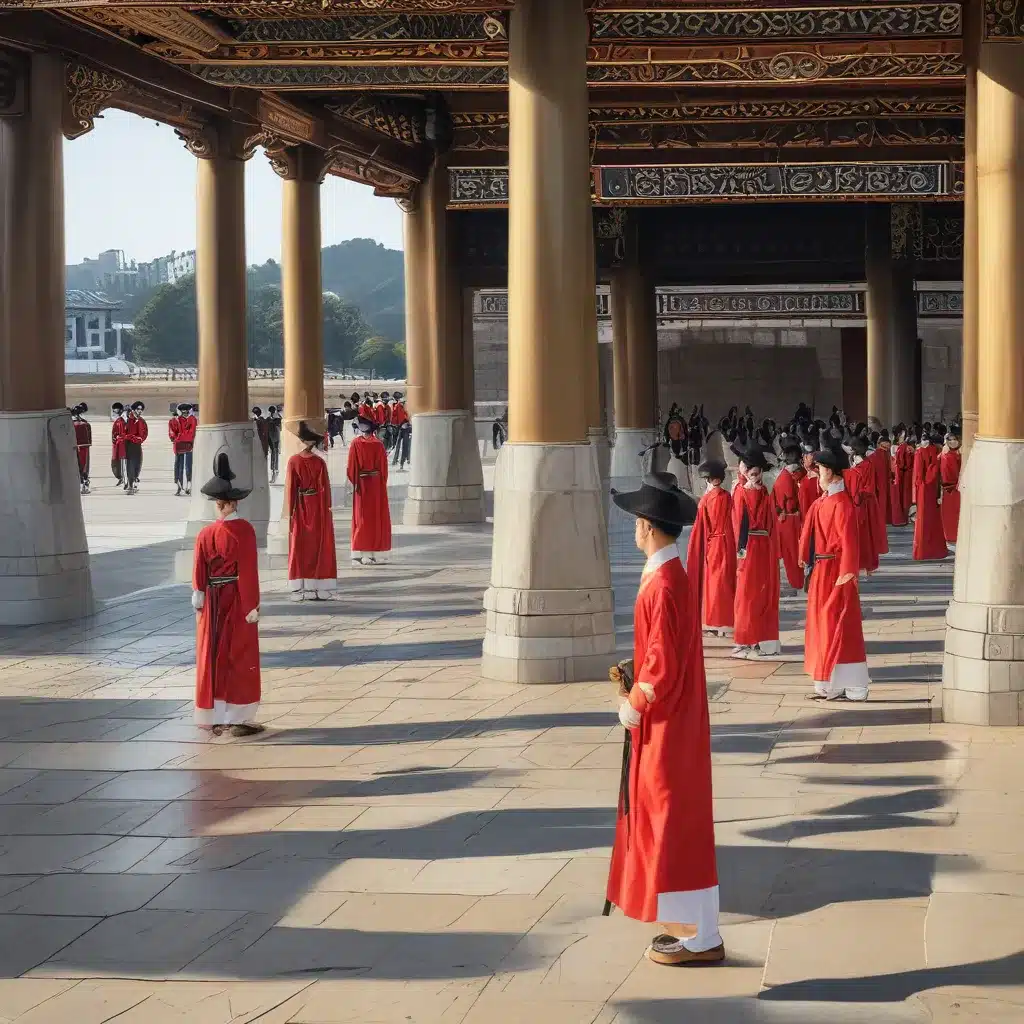
Stepping Back in Time at Gyeongbokgung Palace
As I approached the grand Gwanghwamun Gate, the main entrance to Gyeongbokgung Palace in Seoul, I could feel the anticipation building. Crowds of visitors, many adorned in the traditional Korean Hanbok attire, were eagerly awaiting the spectacle about to unfold – the changing of the royal guards ceremony.
Gyeongbokgung Palace, also known as Gyeongbok Palace, is the largest of the Five Palaces built during the Joseon Dynasty. Its rich history and well-preserved architecture make it one of Seoul’s must-see attractions. But today, I was here for a glimpse into the past, to witness a tradition that has been performed for centuries.
The Pageantry of the Royal Guard Change
As the clock struck 2 pm, the ceremony began with a traditional Korean music ensemble playing rhythmic drums, oboes, and gongs. The palace guards, dressed in their vibrant uniforms, marched in perfect formation towards the gate, carrying replica weapons from the Joseon Dynasty.
The changing of the guard was a meticulously choreographed event, filled with intricate movements and symbolic rituals. As the outgoing and incoming commanders exchanged keys, I couldn’t help but feel transported back in time, to an era when the security of the king and his court was of the utmost importance.
The guards’ discipline and training were evident in their precise synchronization, a testament to the values of respect, honor, and duty that underpinned this timeless tradition. Watching the ceremony unfold, I was captivated by the sense of history and the glimpse it provided into the grandeur of the Joseon Dynasty.
Exploring the Palace Grounds
After the guard change, I ventured deeper into the expansive grounds of Gyeongbokgung Palace, eager to uncover more of its rich history and stunning architecture. The palace’s many buildings and traditional gardens are a testament to the enduring cultural legacy of the Joseon era.
As I strolled through the palace, I was struck by the intricate details that adorned the structures. Colorful bricks were decorated with illustrations of peonies, bamboo, lotus flowers, and butterflies, while the ceilings were adorned with stunning inlaid tiles. It was easy to imagine the palace in its heyday, bustling with the activity of the royal court.
One of the highlights of my exploration was the Geunjeongjeon Hall, the throne room where the king would hold formal audiences and make important declarations. Designated as a National Treasure, this grand hall was the setting for the most significant events in the palace’s history, from coronations to diplomatic receptions.
Hidden Gems and Serene Moments
As I wandered the grounds, I discovered some of Gyeongbokgung’s hidden gems. The Gyeonghoeru Pavilion, with its stunning reflection in the adjacent pond, was a particularly serene and picturesque spot. The Jibokjae, once the private library and meeting room of King Gojong, has been reopened as a public library, offering a glimpse into the intellectual pursuits of the Joseon royalty.
Throughout my exploration, I found moments of tranquility amidst the bustle of the palace. By arriving early, I was able to enjoy the Gyeonghoeru Pavilion in relative solitude, capturing the stillness of the water and the elegant structure before the crowds arrived. These quiet moments allowed me to fully immerse myself in the history and atmosphere of Gyeongbokgung Palace.
Stepping into the Past at the Palace Museums
No visit to Gyeongbokgung Palace would be complete without exploring the two on-site museums, each offering a unique window into the Joseon Dynasty. The National Folk Museum of Korea showcases a vast collection of artifacts, from prehistoric times to the end of the Joseon era, providing a comprehensive look at the daily lives of the Korean people.
The National Palace Museum of Korea, on the other hand, is dedicated to relics from the Joseon Dynasty, including many pieces from Gyeongbokgung itself. The museum’s permanent collection features a breathtaking array of royal costumes, jewelry, and even a bronze dragon discovered in the pond near the Gyeonghoeru Pavilion. These artifacts offer a glimpse into the lavish lives of the Joseon monarchs and their court.
As I wandered through the museums, I couldn’t help but feel a deep sense of connection to the past. The careful preservation and meticulous restoration of Gyeongbokgung Palace and its treasures have ensured that this cultural legacy lives on, allowing visitors like myself to step back in time and immerse ourselves in the grandeur of the Joseon era.
Embracing the Present at Gyeongbokgung
While Gyeongbokgung Palace is a testament to Korea’s rich history, it also serves as a vibrant hub of modern cultural activity. Visitors often don traditional Hanbok clothing, which grants them free admission to the palace grounds, allowing them to fully embrace the spirit of the Joseon Dynasty.
As I strolled through the palace, I encountered families and groups taking photographs in their colorful Hanbok, seamlessly blending the past and present. The lively energy of the visitors added to the overall experience, reminding me that Gyeongbokgung Palace is not just a relic of the past, but a living, breathing cultural icon that continues to captivate and inspire.
Whether you’re drawn to the pageantry of the royal guard change, the serene beauty of the palace architecture, or the rich historical and cultural treasures, a visit to Gyeongbokgung Palace is a must-do for anyone exploring the vibrant city of Seoul. By immersing yourself in this incredible historical site, you’ll come away with a deeper appreciation for Korea’s enduring legacy and a renewed sense of wonder at the power of the human spirit to preserve and celebrate its most cherished traditions.

